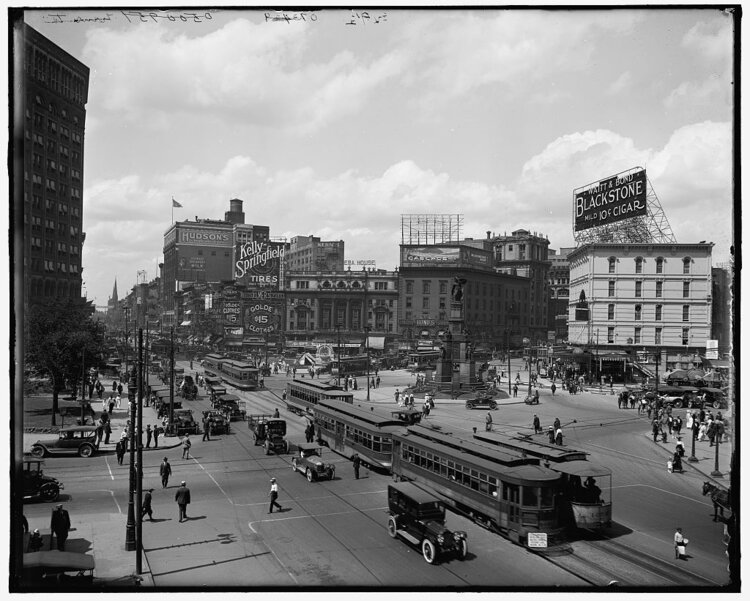| |
 Posted Jul 17, 2021, 4:42 PM
Posted Jul 17, 2021, 4:42 PM
|
 |
Registered User
|
|
Join Date: Aug 2002
Location: Toronto
Posts: 52,200
|
|
|
If "We Are All Detroit," then Woodward Avenue Is Everyroad
If "We Are All Detroit," then Woodward Avenue Is Everyroad
July 13, 2021
By John Pattison
Read More: https://www.strongtowns.org/journal/...e-is-everyroad
Quote:
.....
To deal with congestion, the road was widened from four lanes to eight, which meant razing trees and demolishing buildings. Churches were cut in half. But widening Woodward Avenue into a modern “super highway” didn’t work out the way the project’s boosters (or the Detroit taxpayers) planned. The suburbs grew while the city itself hollowed out, and Woodward Avenue in Detroit began to crumble. Once the fourth-largest city in the U.S., Detroit has lost about two-thirds of its population since 1950. By 2013, the city Augustus Woodward envisioned as the grandest of the American interior was home to ”tens of thousands of abandoned buildings, vacant lots and unlit streets.” It was also groaning under a mountain of debt.
- Strong Towns president Chuck Marohn once wrote an article titled “We Are All Detroit.” The temptation, he said, is to dismiss Detroit as an outlier. But that’s the wrong lesson: Detroit isn’t different from us, just ahead of us. “The auto-centric style of development undermined the resiliency of the city,” Chuck wrote, “tearing down social, political, and financial strength that had made Detroit one of the world's greatest cities. Once this strength was undermined, once Detroit became a fragile city, it was only a matter of time.” A whole continent of towns and cities went all-in on the same development pattern, and, sure enough, many of them are now slipping inexorably toward a similar future if not outright bankruptcy then at least functional insolvency. — If “we are all Detroit,” then Woodward Avenue is Everyroad. At least that’s what came to mind when I read a recent story in Governing magazine called ”Small Cities Can’t Manage the High Cost of Old Infrastructure.” It describes how the mayor of Ferndale, Michigan a northern suburb of Detroit is trying to convert her city’s stretch of Woodward Avenue into a safer, more productive place. Mayor Melanie Piana recently explained in a webcast that the number one reason people move to Ferndale is for its walkability. But Piana also said that the number one complaint she gets from residents is that they feel uncomfortable and unsafe trying to get across the eight lanes of Woodward Avenue.
- The city has a plan to retrofit the Woodward corridor into something that, as Piana said, “knits our downtown together.” But the city can’t afford to do the work itself. The state of Michigan will only pay to maintain Woodward Avenue (M-1) in its current form. According to Governing: “Any efforts to pedestrianize parts of Woodward or efforts to calm traffic even studies to prepare for such moves have to be paid for with resources wrangled by the local government.” Ferndale has applied for a federal grant to help but, even if they get the grant, the city will have to contribute an additional $1.2 million in local funds, “about the amount the city spends on street maintenance for the whole municipality every year.” — This is why I started thinking about Woodward Avenue as Everyroad. All across the Northeast and Midwest, small cities and rural towns many of which had little margin to begin with can no longer afford to maintain or upgrade their aging infrastructure. Costs are going up even as the population and property tax base stagnate or decline. And these same phenomena are coming for other parts of the country, including the Sun Belt and where I live in the Pacific Northwest. — In many cases, more recently developed regions have leveraged population growth to get developers to build a lot of their necessary infrastructure. As a side effect, the consequences of the strict caps that states like California and Washington place on property tax increases were not felt.
- Today, however, population growth is slowing and developers are not on the hook to patch up the infrastructure they built decades ago. Property taxes revenues are not keeping up with regular expenditures, let alone expensive infrastructure investments. In this context, profound local infrastructure problems will not remain a Midwest and Northeastern issue. — So we can look again to Woodward Avenue as a harbinger of what’s to come. Sooner or later, municipalities everywhere will face the challenge of converting dangerous, expensive, and ultimately unproductive stroads into spaces that actually build financial strength and resilience for the community. Similar challenges will loom for other types of infrastructure, including our bridges, water and sewer systems, and more. — We’ll debate how to pay for those changes. For example, Mayor Piana’s webcast was with the Center for American Progress, a liberal think tank making the case that President Biden’s America Jobs Plan is needed to help small cities rebuild and replace critical infrastructure. For his part, Strong Towns President Chuck Marohn wrote about the American Jobs Plan here, and we’ve produced other media about whether the federal government should spend now to hopefully make cities less reliant on Washington later. What’s clearer is that cities shouldn’t wait for urgent fiscal crisis or an act of Congress to begin. There are things you can do right now. The best time to start building your strong town was decades ago. The second best time is today.
.....
|


__________________
ASDFGHJK
|
|
|



